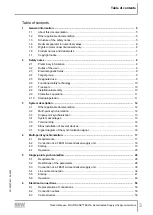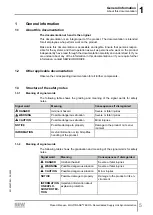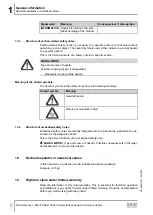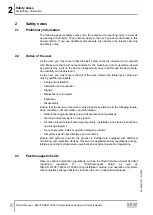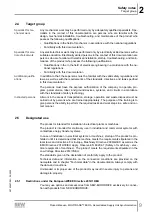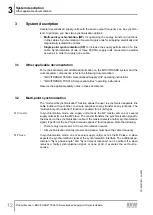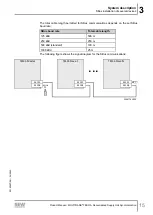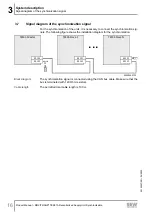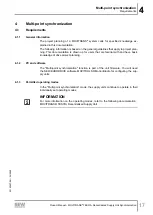
3
System description
Single-point synchronization
Product Manual – MOVITRANS
®
TES31A Decentralized Supply Unit Synchronization
13
3.3
Single-point synchronization
The "single-point synchronization" function allows the user to operate individual
TES31A decentralized supply units in a network. This produces an increase on the
stationary side in the possibly transferable power in a MOVITRANS
®
installation. It is
possible to use the "single-point synchronization" function whenever the power re-
quirements of the application are greater than an individual supply unit at the highest
performance level (14/16 kW) can provide. This function is therefore only available in
supply units as from the performance class 14 kW.
SP master
In synchronization mode, one supply unit acts as the SP master and one or two supply
units act(s) as the SP slave. The master transfers the synchronization signal and the
defined setpoint to the slaves via the synchronization cable. A synchronous enable
control (daisy chain) is produced in combination with the binary inputs/outputs.
The setting "Sync timeout response" is activated. If the master detects another syn-
chronization signal, it performs the set "Sync timeout response" fault response. Note
the following:
•
There is only one master in the synchronization network.
•
All synchronization stations (master and slaves) must have the same frequency.
SP slave
In synchronization mode, one or two supply unit(s) act as the SP slave. A slave ex-
pects the synchronization signal at the synchronization interface and also takes over
the setpoint information sent by the master. In addition, the upstream synchronization
station (master or slaves) expects and passes on the control information of the daisy
chain at the digital inputs/outputs. The additional parameter "Sync phase angle" can
be edited. The setting "Sync timeout response" is activated. If a slave receives a faulty
synchronization signal, or none at all, the unit executes the set fault response.
3.4
System advantages
The essential advantages of the "Single-point synchronization" function are as follows:
•
Output powers up to 48 kW
•
No significant differences in the presentation of the synchronization network com-
pared to a single station (MOVITOOLS® MotionStudio, I/O)
•
No significant restrictions in the unit functionality
•
Simple structure/cabling
•
No additional periphery is required
•
Fault detection and response for this operating mode
29190657/EN – 04/2020



